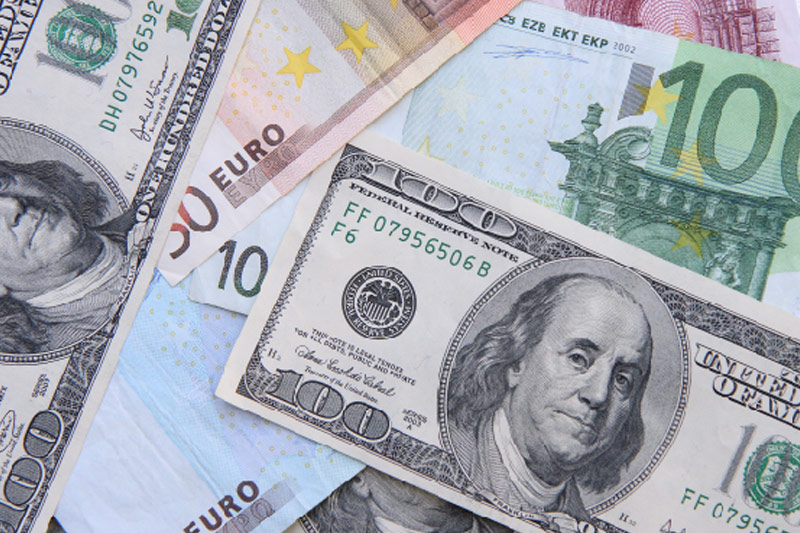Investing.com - The dollar traded largely lower against most major currencies in subdued trading on Wednesday as bargain hunters sent the euro rising on sentiments a European Central Bank decision to trim interest rates in June has been priced into trading.
In U.S. trading on Wednesday, EUR/USD was up 0.06% at 1.3709.
Markets are prepared for the European Central Bank to loosen policy next month.
Reuters reported earlier that the ECB is preparing a “package of measures” including cuts to all interest rates, with negative rates on bank deposits to encourage lending to small and medium-sized businesses to spur recovery.
A day earlier, the Wall Street Journal reported the German central bank Bundesbank would back ECB monetary easing measures, including a negative rate on bank deposits and purchases of packaged bank loans, if such tools were needed to keep persistently low levels of inflation from becoming entrenched in the euro zone.
Last week, ECB President Mario Draghi said monetary authorities were “comfortable” with acting at its next meeting in June.
By afternoon trading on Wednesday, the euro rebounded on demand from bottom fishers, as easing measures aren't a surprise after months of soft inflation rates and other euro zone data.
Elsewhere, industrial production in the euro zone fell in line with expectations in March, though the soft numbers underlined concerns over the outlook for economic growth in the single currency bloc, official data showed on Wednesday.
In a report, Eurostat, the European statistics agency, said industrial production declined by 0.3% in March, in line with forecasts. Industrial production in February rose 0.2%.
Year-on-year, industrial production fell 0.1% in March, disappointing expectations for a 1.0% gain and after rising at a rate of 1.7% in the preceding month.
Meanwhile in the U.S., producer price inflation rose more than expected in April, while core wholesale prices also topped forecasts, official data showed on Wednesday.
The Commerce Department reported earlier that producer prices increased by 0.6% last month, beating forecasts for a 0.2% gain, after rising 0.5% in March.
Year-over-year, the producer price index rose 2.1% in April, beating expectations for a 1.7% increase and up from 1.4% in the preceding month.
The core producer price index advanced 0.5% last month, compared to expectations for a 0.2% increase, after rising 0.6% in March.
Core produces prices rose at an annualized rate of 1.9% in April, beating forecasts for a 1.4% gain and after climbing 1.4% in the preceding month.
The Federal Reserve views core prices as a better gauge of longer-term inflationary pressure because they exclude the volatile food and energy categories.
The dollar was down against the yen, with USD/JPY down 0.45% at 101.81 and down against the Swiss franc, with USD/CHF down 0.03% at 0.8899.
The greenback was up against the pound, with GBP/USD down 0.34% at 1.6768.
In the U.K. earlier, the Bank of England left its growth and inflation forecasts largely unchanged and played down speculation over the timing of a possible rate hike.
The bank said in its quarterly inflation report that it now expects economic growth of 2.9% in 2015, up from 2.7% in its February report, and said the rate of growth this year would remain unchanged at 3.4%.
The bank said it expects annual inflation to be close to its 2% target over the next two to three years if interest rates in the U.K. rise in line with expectations in financial markets.
In addition, official data showed that the U.K. unemployment rate ticked down to a more than five-year low of 6.8% in the three months to March from 6.9% in the three months to February, in line with expectations.
The claimant count fell by 25,100 last month, the ONS said, compared to expectations for a decline of 30,000 people. March’s figure was revised to a drop of 30,600 people from a previously reported decline of 30,400.
The report said that average weekly earnings rose by 1.7% on a year-over-year basis in the three months to March, but excluding bonuses average earnings only rose by 1.3% during the quarter, and just 1.0% in March.
The dollar was down against its cousins in Canada, Australia and New Zealand, with USD/CAD down 0.25% at 1.0878, AUD/USD up 0.21% at 0.9378 and NZD/USD up 0.42% at 0.8664.
The US Dollar Index, which tracks the performance of the greenback versus a basket of six other major currencies, was down 0.07% at 80.13.
On Thursday, the U.S. is to release data on initial jobless claims, consumer inflation and industrial production, as well as a report on manufacturing activity in the Philadelphia region.
